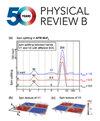Wavenumber-dependent magnetic losses in yttrium iron garnet–gadolinium gallium garnet heterostructures at millikelvin temperatures
IF 3.7
2区 物理与天体物理
Q1 Physics and Astronomy
引用次数: 0
Abstract
Magnons have inspired potential applications in modern quantum technologies and hybrid quantum systems due to their intrinsic nonlinearity, nanoscale scalability, and a unique set of experimentally accessible parameters for manipulating their dispersion. Such magnon-based quantum technologies demand long decoherence times, millikelvin temperatures, and minimal dissipation. Due to its low magnetic damping, the ferrimagnet yttrium iron garnet (YIG), grown on gadolinium gallium garnet (GGG), is the most promising material for this objective. To comprehend the magnetic losses of propagating magnons in such YIG-GGG heterostructures at cryogenic temperatures, we investigate magnon transport in a micrometer-thick YIG sample via propagating spin-wave spectroscopy measurements for temperatures between 4K to毫开尔文温度下钇铁石榴石-钆镓石榴石异质结构中波数相关的磁损耗
磁振子由于其固有的非线性、纳米级的可扩展性和一组独特的实验参数来操纵其色散,在现代量子技术和混合量子系统中激发了潜在的应用。这种基于磁振子的量子技术需要很长的退相干时间、毫开尔文温度和最小的耗散。由于其低磁阻尼,生长在钆镓石榴石(GGG)上的铁磁铁钇铁石榴石(YIG)是最有希望实现这一目标的材料。为了了解在低温下这种YIG- ggg异质结构中传播磁振子的磁损失,我们在4K至26mK的温度范围内通过传播自旋波光谱测量研究了微米厚YIG样品中的磁振子输运。我们证明了在低温下,由于与部分磁化的GGG衬底的偶极耦合,耗散率随波数的增加而增加。此外,我们观察到自旋波传输的温度依赖性下降,归因于稀土离子弛豫。将实验结果与理论计算和微磁模拟结果进行了比较,证明了附加耗散通道在低温下的关键作用。我们的发现加强了对毫开尔文温度下的磁振子损耗的理解,这对未来探测单个传播的磁振子是必不可少的。2025年由美国物理学会出版
本文章由计算机程序翻译,如有差异,请以英文原文为准。
求助全文
约1分钟内获得全文
求助全文
来源期刊

Physical Review B
物理-物理:凝聚态物理
CiteScore
6.70
自引率
32.40%
发文量
0
审稿时长
3.0 months
期刊介绍:
Physical Review B (PRB) is the world’s largest dedicated physics journal, publishing approximately 100 new, high-quality papers each week. The most highly cited journal in condensed matter physics, PRB provides outstanding depth and breadth of coverage, combined with unrivaled context and background for ongoing research by scientists worldwide.
PRB covers the full range of condensed matter, materials physics, and related subfields, including:
-Structure and phase transitions
-Ferroelectrics and multiferroics
-Disordered systems and alloys
-Magnetism
-Superconductivity
-Electronic structure, photonics, and metamaterials
-Semiconductors and mesoscopic systems
-Surfaces, nanoscience, and two-dimensional materials
-Topological states of matter
 求助内容:
求助内容: 应助结果提醒方式:
应助结果提醒方式:


